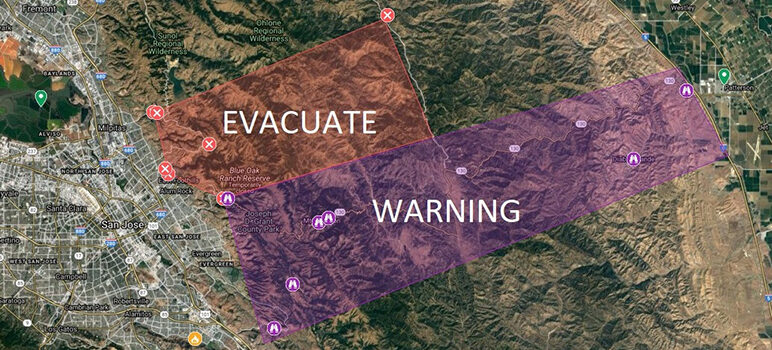Though skies cleared today over Santa Clara Valley, the fires continue to rage.
Three sweeping wildfire complexes sparked by Sunday’s freak lightning storms engulfed 250,000 acres across a dozen Northern California counties by late Wednesday and continue to burn today with virtually no containment.
The blazes prompted evacuations for tens of thousands of people from the eastern edge of San Jose to North Bay’s wine country.
Threatening Santa Clara County is the SCU Complex, which devoured nearly 140,000 acres by today with 5 percent containment, according to the latest update from Cal Fire. So far, at least, no structures have been damaged.
After opening a resource hub at the Milpitas Library Wednesday for evacuees, county officials activated a second one this morning at Ann Sobrato High in Morgan Hill. The American Red Cross is staffing both centers to help people fleeing the fires figure out where to find temporary shelter, among other things.
“All residents under an evacuation order are urged to take rapid action and leave the area immediately ahead of the fast-moving and unpredictable wildfire,” county officials said in an update posted online early Thursday.
An information hotline has been set up for evacuees only at 408.808.7778. General fire updates are available online here: http://bit.ly/LightningComplex-SCC.
The information line for the SCU Complex—a knot of about 20 fires spanning Santa Clara, Alameda, Contra Costa, San Joaquin and Stanlislaus counties—is 669.247.7431.
#SCULightningComplex Incident Update 8/20/20 8AM pic.twitter.com/dYxBebCoJQ
— CAL FIRE SCU (@calfireSCU) August 20, 2020
Meanwhile, the CZU Complex on the Peninsula ballooned overnight by 15,000 acres to 40,000 acres this morning without zero containment, Cal Fire reported.
Officials warned residents to still expect significant growth as the blaze encroaches on ancient redwoods and historic buildings in and around Big Basin State Park.
Up in the North Bay is the LNU Complex—the Bay Area’s largest and most devastating group of fires this week—has burned 50 structures. The flames on Wednesday night extended past Interstate 80, scorching more than 124,000 acres with no containment.
Evacuations were ordered in San Jose’s east foothills as well as in San Mateo, Santa Cruz and Sonoma counties. But Cal Fire urged everyone in the whole state to “be ready to go.”
Already hammered by the coronavirus pandemic, California’s firefighting ability has been stretched to the limits this week by nearly 11,000 lightning strikes that ignited 367 fires, There were so many at the same time that the state—which normally dubs each distinct fire—resorted to naming groups of them for expediency’s sake.
“Firefighting resources are depleted as new fires continue to ignite,” Cal Fire spokesman Jeremy Rahn said at his latest press briefing, which took place this morning in Calistoga.
In all, about 6,900 firefighters deployed statewide, officials said. But Cal Fire is looking for more help wherever it can. Rahn said the agency asked its out-of-state counterparts to send 375 additional fire engines, “hand crews” and other resources to continue the fight.
Cal Fire has fought slews of fires at once before. But Covid-19’s disproportionate impact on inmates have hampered the agency because of its reliance on prison labor.
The state recently announced that it expects to have about a dozen fewer inmate firefighting crews this fire season because prisons have been releasing people to curb the pandemic, bringing the incarcerated population down by about 10 percent from 2019.
According to the California Department of Corrections and Rehabilitation, Cal Fire had 2,800 inmate firefighters to activate in 2019 compared to just 2,026 this year. Cal Fire uses inmates—who only make about $1 an hour—to use hand tools, such as chainsaws, to cut firelines in places inaccessible to bulldozers, or if machines aren’t available.
At a press conference Wednesday, Gov. Gavin Newsom agreed that the state is in dire need of outside help. That’s despite him budgeting $85.6 million this year to hire more firefighters and another $72.4 million for temporary fire personnel—830 of whom have already been recruited and deployed.
“We’ve put out every resource we have,” he told reporters.
Still, Newsom added: “This is an incredibly resilient state. We will get through this moment in time as we have in the past. Many of these conditions, while they may be stacked up on top of each other, are familiar.”

